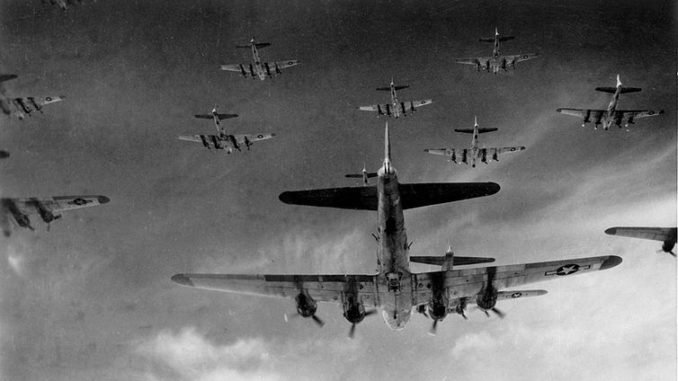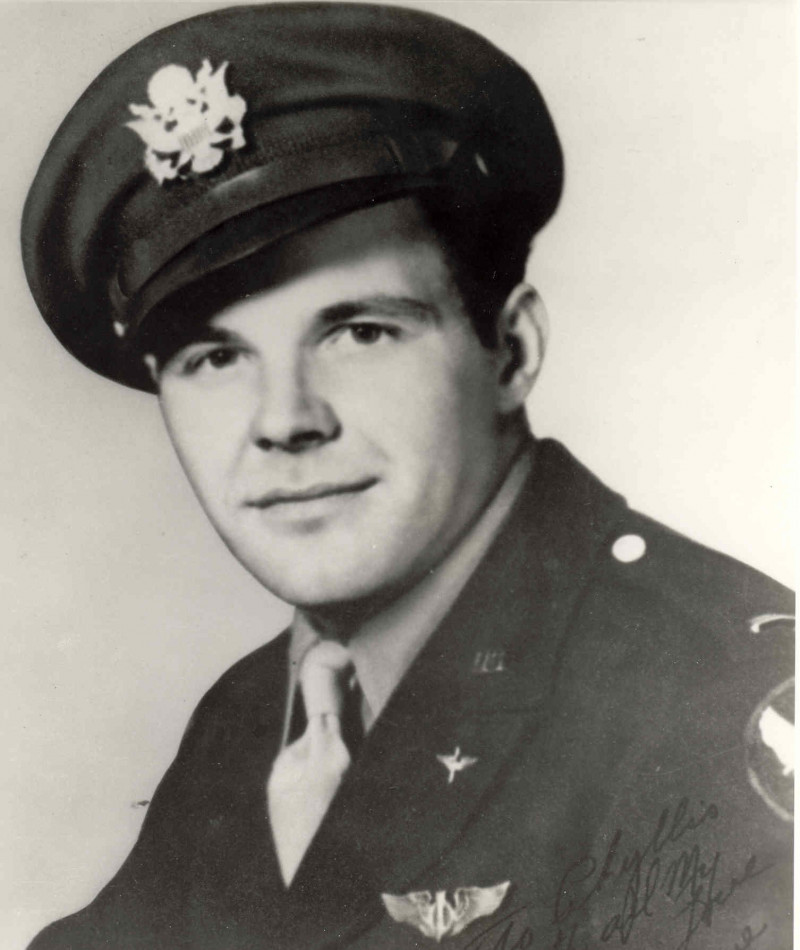
On 23 June 1944, B-17 Flying Fortresses of the 97th Bombardment Group took off from their base in Italy on yet another bombing mission against oil refineries at Ploesti, Rumania. The refineries were critical to the needs of the Nazi war effort and a frequent target of US Army Air Forces heavy bombers.
As the bombers neared the target they were attacked by enemy fighters. Two bombers were shot down before the fighters broke off and anti-aircraft flak commenced. They were very close to the refineries now. One of the American B-17s, named ‘OPISSONYA’, was hit by the intense flak and severely damaged with the loss of an engine and a fuel tank. The pilot, First Lieutenant Edwin Anderson, managed to keep the aircraft on track toward the target where the bombardier, Second Lieutenant David Kingsley focused on the target through his bombsight. At the right moment, Kingsley released OPISSONYA’s load of bombs and returned control of the aircraft to the pilot.
With one engine out, OPISSONYA could not keep up with the group formation and fell behind. Out of range of the flak, they once again found themselves the target of Messerschmitt Bf 109 fighters. Concentrating on the B-17’s tail gunner, a bullet from the 109s hit Sergeant Michael Sullivan in the shoulder, simultaneously damaging his parachute harness and disabling the tail gun. Sullivan crawled forward to the waist gunner positions, who called Kingsley on the intercom for help. Kingsley hurried back to the rear of the plane where he removed Sullivan’s damaged parachute and administered first aid.
A pair of P-51 Mustangs showed up and chased off the 109s, giving the bomber crew a break for awhile. Eventually the Mustangs were low on fuel and had to head for home, leaving the unfortunate crew on their own.
Another eight Bf-109s found OPISSONYA and ruthlessly pummeled the crippled aircraft, which began to lose altitude. The damage was so great, Anderson feared the plane might break apart in midair and signaled to the crew to prepare to bailout.
Kingsley was still in the back aiding the injured, who by this time included the ball turret gunner. The floor was covered with blankets, bandages, and assorted debris including empty shells from the waist guns. Sullivan’s parachute could not be found. Presumably it was somewhere under the clutter. Anderson put the plane on autopilot and gave the order to bailout.
Without hesitating, Kingsley took off his parachute and put it on Sullivan. He then helped Sullivan to the open bomb bay, told him to hold on to the ripcord handle and not let go, and ordered him to jump. All crewmembers except Kingsley made it out of the plane. The B-17, with Kingsley still on board, crashed in the village of Suhozem, Bulgaria.

Congressional Medal of Honor citation:
For conspicuous gallantry and intrepidity in action at the risk of life above and beyond the call of duty, 23 June 1944 near Ploesti, Rumania, while flying as bombardier of a B-17 type aircraft. On the bomb run 2d Lt. Kingsley’s aircraft was severely damaged by intense flak and forced to drop out of formation, but the pilot proceeded over the target and 2d Lt. Kingsley successfully dropped his bombs, causing severe damage to vital installations. The damaged aircraft, forced to lose altitude and to lag behind the formation, was aggressively attacked by three ME-109 aircraft, causing more damage to the aircraft and severely wounding the tail gunner in the upper arm. The radio operator and engineer notified 2d Lt. Kingsley that the tail gunner had been wounded and that assistance was needed to check the bleeding. Second Lt. Kingsley made his way back to the radio room, skillfully applied first aid to the wound, and succeeded in checking the bleeding. The tail gunner’s parachute harness and heavy clothes were removed and he was covered with blankets, making him as comfortable as possible. Eight ME-109 aircraft again aggressively attacked 2d Lt. Kingsley’s aircraft and the ball turret gunner was wounded by 20-mm shell fragments. He went forward to the radio room to have 2d Lt. Kingsley administer first aid. A few minutes later when the pilot gave the order to prepare to bail out, 2d Lt. Kingsley immediately began to assist the wounded gunners in putting on their parachute harness. In the confusion, the tail gunner’s harness, believed to have been damaged, could not be located in the bundle of blankets and flying clothes which had been removed from the wounded men. With utter disregard for his own means of escape, 2d Lt. Kingsley unhesitatingly removed his parachute harness and adjusted it to the wounded tail gunner. Due to the extensive damage caused by the accurate and concentrated 20-mm fire by the enemy aircraft the pilot gave the order to bail out, as it appeared that the aircraft would disintegrate at any moment. Second Lt. Kingsley aided the wounded men in bailing out and when last seen by the crewmembers he was standing on the bomb bay catwalk. The aircraft continued to fly on automatic pilot for a short distance, then crashed and burned. His body was later found in the wreckage. Second Lt. Kingsley by his gallant and heroic action was directly responsible for saving the life of the wounded gunner.
cmohs.org
A family of seven on the ground in Suhozem were killed by the crash. The village erected a memorial to Kingsley and the seven family members in 2004.
David R. Kingsley was born on June 27, 1918, and died June 23, 1944, just four days short of his 26th birthday. The Klamath Falls Airport in Oregon is named Kingsley Field in his honor.
Question of the Night: Are the temperatures dropping in your part of the country yet?
